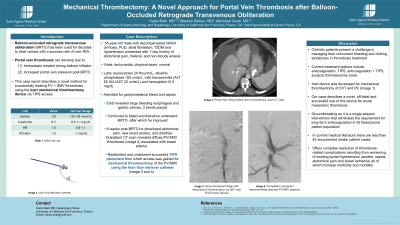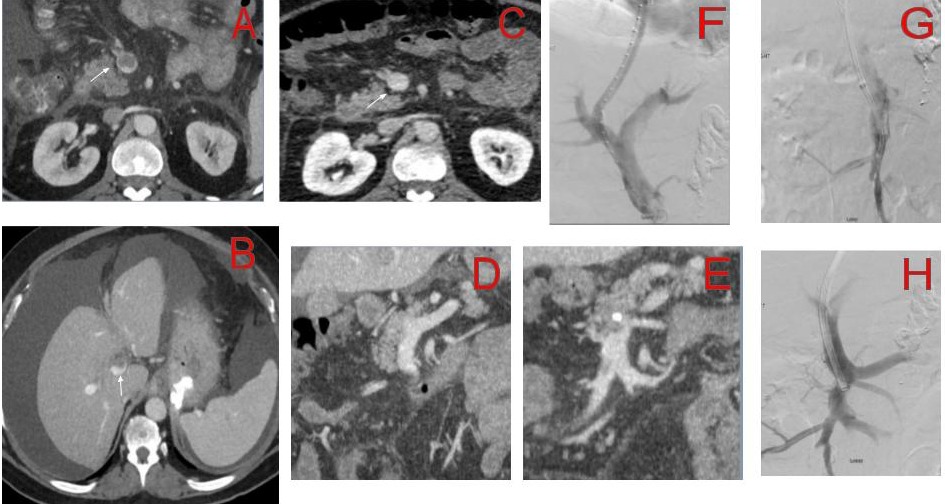Sunday Poster Session
Category: Liver
P1045 - Mechanical Thrombectomy: A Novel Approach for Portal Vein Thrombosis After Balloon-Occluded Retrograde Transvenous Obliteration
Sunday, October 22, 2023
3:30 PM - 7:00 PM PT
Location: Exhibit Hall

Has Audio

Harjot Bath, MD
University of California San Francisco, Fresno
Fresno, CA
Presenting Author(s)
Award: Presidential Poster Award
Harjot Bath, MD1, Stephen Balfour, MD2, Abhishek Gulati, MD3
1University of California San Francisco, Fresno, Fresno, CA; 2Saint Agnes Medical Center, Clovis, CA; 3Clovis Community Medical Center, Clovis, CA
Introduction: Balloon-occluded retrograde transvenous obliteration (BRTO) has been used for several decades to treat varices with a success rate of over 90%. However portal vein thrombosis (PVT) can develop due to hemostasis created during balloon inflation and increased portal vein pressures post-BRTO. This case report describes a novel method for successfully treating PVT and superior mesenteric vein (SMV) thrombosis using the Inari mechanical thrombectomy device via transjugular intrahepatic portosystemic shunt access (TIPS).
Case Description/Methods: A 55-year-old male with a past medical history of decompensated cirrhosis secondary to non-alcoholic steatohepatitis, atrial fibrillation, diabetes and hypertension presented to the hospital with a one-day history of abdominal pain, melena, and emesis. On admission, his vitals were significant for tachycardia and physical exam was normal. Laboratory results revealed leukocytosis of 24 thou/mcL, alkaline phosphatase 150 units/L, mild transaminitis, and hemoglobin of 10.5 mg/dL. He was admitted for further management of gastrointestinal (GI) bleed and sepsis. Endoscopy revealed bleeding esophageal and gastric fundic varices, esophageal varices were banded. He continued to bleed and therefore underwent BRTO, after which he improved and was discharged home. Six weeks post-BRTO he developed abdominal pain, bloating, and diarrhea. An outpatient CT scan revealed diffuse portal and mesenteric thrombosis associated with both large and small bowel edema. He was readmitted and underwent a successful TIPS procedure from which access was gained for mechanical thrombectomy of the PV/SMV using the Inari device. This device was developed and is primarily used for mechanical thrombectomy of deep vein thrombosis and pulmonary embolism. This case describes a novel, off-label and successful use of this device for mesenteric thrombosis.
Discussion: In conclusion, cirrhotic patients present a challenge in managing their concurrent bleeding and clotting tendencies. In current medical literature, there are less than 40 documented patient cases similar to ours. The successful application of mechanical thrombectomy of PV and SMV thrombosis is groundbreaking as it is a single-session intervention that eliminates the requirement for long-term anticoagulation in cirrhotic patients that are prone to GI bleeds. It also offers relief of porto-mesenteric clot-associated complications from worsening of existing portal hypertension such as ascites, abdominal pain and bowel ischemia.

Disclosures:
Harjot Bath, MD1, Stephen Balfour, MD2, Abhishek Gulati, MD3. P1045 - Mechanical Thrombectomy: A Novel Approach for Portal Vein Thrombosis After Balloon-Occluded Retrograde Transvenous Obliteration, ACG 2023 Annual Scientific Meeting Abstracts. Vancouver, BC, Canada: American College of Gastroenterology.
Harjot Bath, MD1, Stephen Balfour, MD2, Abhishek Gulati, MD3
1University of California San Francisco, Fresno, Fresno, CA; 2Saint Agnes Medical Center, Clovis, CA; 3Clovis Community Medical Center, Clovis, CA
Introduction: Balloon-occluded retrograde transvenous obliteration (BRTO) has been used for several decades to treat varices with a success rate of over 90%. However portal vein thrombosis (PVT) can develop due to hemostasis created during balloon inflation and increased portal vein pressures post-BRTO. This case report describes a novel method for successfully treating PVT and superior mesenteric vein (SMV) thrombosis using the Inari mechanical thrombectomy device via transjugular intrahepatic portosystemic shunt access (TIPS).
Case Description/Methods: A 55-year-old male with a past medical history of decompensated cirrhosis secondary to non-alcoholic steatohepatitis, atrial fibrillation, diabetes and hypertension presented to the hospital with a one-day history of abdominal pain, melena, and emesis. On admission, his vitals were significant for tachycardia and physical exam was normal. Laboratory results revealed leukocytosis of 24 thou/mcL, alkaline phosphatase 150 units/L, mild transaminitis, and hemoglobin of 10.5 mg/dL. He was admitted for further management of gastrointestinal (GI) bleed and sepsis. Endoscopy revealed bleeding esophageal and gastric fundic varices, esophageal varices were banded. He continued to bleed and therefore underwent BRTO, after which he improved and was discharged home. Six weeks post-BRTO he developed abdominal pain, bloating, and diarrhea. An outpatient CT scan revealed diffuse portal and mesenteric thrombosis associated with both large and small bowel edema. He was readmitted and underwent a successful TIPS procedure from which access was gained for mechanical thrombectomy of the PV/SMV using the Inari device. This device was developed and is primarily used for mechanical thrombectomy of deep vein thrombosis and pulmonary embolism. This case describes a novel, off-label and successful use of this device for mesenteric thrombosis.
Discussion: In conclusion, cirrhotic patients present a challenge in managing their concurrent bleeding and clotting tendencies. In current medical literature, there are less than 40 documented patient cases similar to ours. The successful application of mechanical thrombectomy of PV and SMV thrombosis is groundbreaking as it is a single-session intervention that eliminates the requirement for long-term anticoagulation in cirrhotic patients that are prone to GI bleeds. It also offers relief of porto-mesenteric clot-associated complications from worsening of existing portal hypertension such as ascites, abdominal pain and bowel ischemia.

Figure: A. Superior Mesenteric Vein Filling Defect due to Thrombosis, axial CT view
B.Portal Vein Filling Defect due to Thrombosis, axial CT view
C.Patent Superior Mesenteric Vein post-thrombectomy, axial CT view
D. Patent Portal Vein post thrombectomy, coronal CT view
E. Patent Superior Mesenteric Vein post thrombectomy, coronal CT view
F. Intra-procedural image of TIPS creation
G. Intra-procedural image with SMV thrombectomy via 20F Inari FlowTriever Device
H. Completion venogram demonstrating restored Superior Mesenteric Vein patency
B.Portal Vein Filling Defect due to Thrombosis, axial CT view
C.Patent Superior Mesenteric Vein post-thrombectomy, axial CT view
D. Patent Portal Vein post thrombectomy, coronal CT view
E. Patent Superior Mesenteric Vein post thrombectomy, coronal CT view
F. Intra-procedural image of TIPS creation
G. Intra-procedural image with SMV thrombectomy via 20F Inari FlowTriever Device
H. Completion venogram demonstrating restored Superior Mesenteric Vein patency
Disclosures:
Harjot Bath indicated no relevant financial relationships.
Stephen Balfour: Inari Medical – Consultant.
Abhishek Gulati indicated no relevant financial relationships.
Harjot Bath, MD1, Stephen Balfour, MD2, Abhishek Gulati, MD3. P1045 - Mechanical Thrombectomy: A Novel Approach for Portal Vein Thrombosis After Balloon-Occluded Retrograde Transvenous Obliteration, ACG 2023 Annual Scientific Meeting Abstracts. Vancouver, BC, Canada: American College of Gastroenterology.

